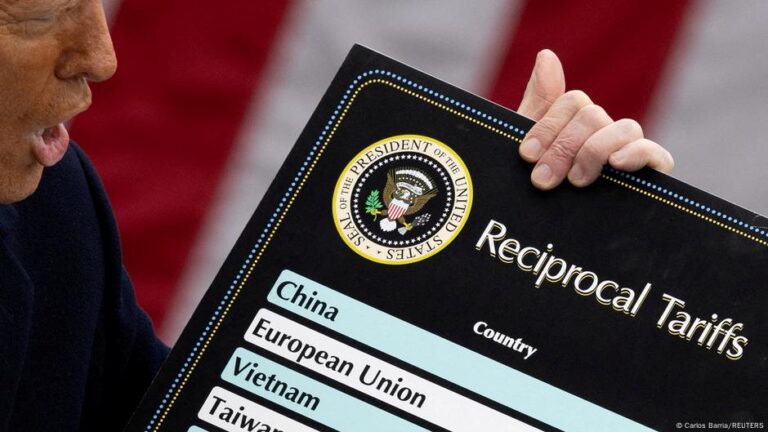In his election campaign, Donald Trump once said that “tariff is the most beautiful word in the dictionary.” Now, after six months in office, the US president is eager to turn his very specific vison of global trade into reality.
With a move that shocked both politics and business across the world, Donald Trump announced on April 2 this year that he would impose a “baseline tariff” of 10% on all goods imported to the United States.
In addition, goods from about 60 other trade partners would face so-called reciprocal tariffs that were even higher and meant as payback for the unfair trade policies of what Trump called “the worst offenders.”
While the baseline tariffs came into effect immediately, the US President was forced to postpone the deadline for reciprocal tariffs for 90 days in response to turmoil in the financial markets following April 2.
They are now coming into effect on August 1, with the US president having made abundantly clear that he’s holding strong on the deadline for countries that haven’t reached new trade agreements with his administration.
“It stands strong, and will not be extended,” Trump wrote in a Truth Social post on Tuesday, adding: “A big day for America!!!”
While deals have been made with some major US trading partners, many others are facing the prospect of no deal and increased levies on their exports to the United States.
Scores more are somewhere in the middle — with no trade deal signed, but as yet no threat of higher tariffs. Among them are some of America’s closet allies and biggest trading partners, including Australia, Taiwan and New Zealand.
Deals done
Days before the deadline, the US and the European Union on Sunday agreed that European goods imported to the US would face a 15% baseline tariff. This includes the EU’s crucial automobile sector which had been subject to a 25% levy since Trump took office earlier this year.
By contrast, the EU will charge US firms no duties at all, and has pledged to buy US energy worth $750 billion (€656 billion), as well as make investments in the US of around $600 billion, according to the White House.
The agreement, which still needs to be signed off by all 27 EU members, has already received strong criticism. French Prime Minister Francoise Bayrou said the EU had capitulated and described Sunday as a “dark day.”
The United Kingdom was the first country to strike a trade deal with Washington.
British products will be subject to a 10% base rate, with exceptions for some industries. The UK is still negotiating exemptions for its steel and aluminium products from the 25% rate in force. In return, the UK had to open its market further to US ethanol and beef.
Under a deal struck in July, Japan’s exports to the US will be taxed at 15%, including automobiles, an industry accounting for 30% of Japanese exports to the US in 2024.
Tariffs of 50% on Japanese steel and aluminium will continue to apply and the White House said that under the deal, Japan would make an unspecified $550 billion investments in the US.
With regard to South Korea, recent negotiations have resulted in a 15% baseline tariff on all imports from that country — down from a threatened 25% for one of the US’s top-10 trading partner and key Asian ally.
Trump said on Wednesday that South Korea had also agreed to invest $350 billion in US projects and to purchase $100 billion of liquefied natural gas and other energy products.
Furthermore, South Korea will accept American products, including automobiles and agricultural goods into its markets and impose no import duties on them, he added.
Other trade deals made by Washington include the Philippines, Vietnam, Indonesia, and Pakistan.
Products from the Philippines — a major exporter of hi-tech items and apparel — will face a 19% levy. Vietnam was able to lower a threatened reciprocal tariff of 49% under a deal reached in early July. A main exporter of clothing and shoes to the US, Vietnam will see its shipments subject to a 20% tariff.
However, a 40% tariff will be imposed on so-called transshipments — goods manufactured in third countries that use Vietnam to circumvent steeper trade barriers. US goods will not face any tariffs entering Vietnam.
Indonesian exports to the US will be taxed at 19% and, according to Washington, nearly all US goods will be able to enter Indonesia tariff-free.
Pakistan, which was facing a potential 29% tariff under Trump’s April 2 announcement, said on Thursday it had struck a deal that would result in lower tariffs, as well as an agreement in which Washington would help develop the country’s oil reserves.
China — the world’s second-largest economy — is a special case. Washington and Beijing had raised tariffs on each other’s goods to more than 100% before temporarily lowering rates for a 90-day period. That pause is set to end on 12 August.
China has taken an aggressive stance in response to Trump’s brief threat of imposing a 145% levy on imports, retaliating with tariffs of its own on US goods and blocking the sale of vital rare earth minerals and components used by American defense and hi-tech manufacturers.
Holdouts face escalation
Brazil is one of the few major economies that run a trade deficit with the United States, meaning Brazil imports more from the US than it exports to the country.
Nevertheless, the US president has threatened to impose a 50% tariff on Brazil’s products because of political differences. Trump called a current trial against former Brazilian President Jair Bolsonaro a “witch hunt,” and has demanded the release of the ultraconservative politician.
Brazil’s president, Luiz Inacio Lula da Silva, in turn called Trump an “emperor” and said he didn’t fear publicly criticizing Trump.
India, meanwhile, has caused Trump’s ire for its huge trade surplus with the US and its trade ties with Russia.
As a result, Trump announced on Wednesday that he would impose a 25% tariff on Indian goods, plus an additional “penalty” because of India’s purchasing of Russian oil that helps Moscow finance its war in Ukraine.
On his Truth Social platform, Trump also wrote that India “is our friend,” but added its tariffs on US products “are far too high.”
Canada and Mexico — two of the the US’s biggest trading partners — haven’t been spared Trump’s tariff threats either, even though the three neighbors’ trade is governed by the US-Mexico-Canada (USMC) trade agreement.
Trump has threatened to impose a 30% tariff on Mexican goods, accusing the country of not doing enough to curb drug smuggling. Nevertheless, Mexican President Claudia Sheinbaum has previously said she was confident an agreement could be reached before August 1.
Canadian Prime Minister Mark Carney is more skeptical about a positive outcome of bilateral trade talks after Trump has threatened to impose a 35% levy on imports not covered by USMC.
In March, Trump already imposed a 25% tariff on Canadian cars and auto parts, adding a 50% levy on steel and aluminium imports in June. The new rate would apply to all other goods.
On Wednesday, Trump said that Canada’s decision to back statehood for Palestine would make it “hard for us to make a trade deal with them.”
Edited by: Kristie Pladson


